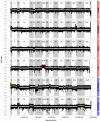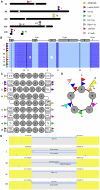Whole-genome comparison reveals novel genetic elements that characterize the genome of industrial strains of Saccharomyces cerevisiae
- PMID: 21304888
- PMCID: PMC3033381
- DOI: 10.1371/journal.pgen.1001287
Whole-genome comparison reveals novel genetic elements that characterize the genome of industrial strains of Saccharomyces cerevisiae
Abstract
Human intervention has subjected the yeast Saccharomyces cerevisiae to multiple rounds of independent domestication and thousands of generations of artificial selection. As a result, this species comprises a genetically diverse collection of natural isolates as well as domesticated strains that are used in specific industrial applications. However the scope of genetic diversity that was captured during the domesticated evolution of the industrial representatives of this important organism remains to be determined. To begin to address this, we have produced whole-genome assemblies of six commercial strains of S. cerevisiae (four wine and two brewing strains). These represent the first genome assemblies produced from S. cerevisiae strains in their industrially-used forms and the first high-quality assemblies for S. cerevisiae strains used in brewing. By comparing these sequences to six existing high-coverage S. cerevisiae genome assemblies, clear signatures were found that defined each industrial class of yeast. This genetic variation was comprised of both single nucleotide polymorphisms and large-scale insertions and deletions, with the latter often being associated with ORF heterogeneity between strains. This included the discovery of more than twenty probable genes that had not been identified previously in the S. cerevisiae genome. Comparison of this large number of S. cerevisiae strains also enabled the characterization of a cluster of five ORFs that have integrated into the genomes of the wine and bioethanol strains on multiple occasions and at diverse genomic locations via what appears to involve the resolution of a circular DNA intermediate. This work suggests that, despite the scrutiny that has been directed at the yeast genome, there remains a significant reservoir of ORFs and novel modes of genetic transmission that may have significant phenotypic impact in this important model and industrial species.
Conflict of interest statement
BAD, DR, JPA, and ME were employees of 454 Life Sciences, A Roche Company, at the time this work was performed.
Figures





Similar articles
-
Comparative genome analysis of a Saccharomyces cerevisiae wine strain.FEMS Yeast Res. 2008 Nov;8(7):1185-95. doi: 10.1111/j.1567-1364.2008.00434.x. Epub 2008 Sep 4. FEMS Yeast Res. 2008. PMID: 18778279
-
Whole Genome Comparison Reveals High Levels of Inbreeding and Strain Redundancy Across the Spectrum of Commercial Wine Strains of Saccharomyces cerevisiae.G3 (Bethesda). 2016 Apr 7;6(4):957-71. doi: 10.1534/g3.115.025692. G3 (Bethesda). 2016. PMID: 26869621 Free PMC article.
-
Genome sequencing and genetic breeding of a bioethanol Saccharomyces cerevisiae strain YJS329.BMC Genomics. 2012 Sep 15;13:479. doi: 10.1186/1471-2164-13-479. BMC Genomics. 2012. PMID: 22978491 Free PMC article.
-
Lager-brewing yeasts in the era of modern genetics.FEMS Yeast Res. 2019 Nov 1;19(7):foz063. doi: 10.1093/femsyr/foz063. FEMS Yeast Res. 2019. PMID: 31553794 Free PMC article. Review.
-
Origins, evolution, domestication and diversity of Saccharomyces beer yeasts.Curr Opin Biotechnol. 2018 Feb;49:148-155. doi: 10.1016/j.copbio.2017.08.005. Epub 2017 Sep 3. Curr Opin Biotechnol. 2018. PMID: 28869826 Review.
Cited by
-
Lifestyle, Lineage, and Geographical Origin Influence Temperature-Dependent Phenotypic Variation across Yeast Strains during Wine Fermentation.Microorganisms. 2020 Sep 7;8(9):1367. doi: 10.3390/microorganisms8091367. Microorganisms. 2020. PMID: 32906626 Free PMC article.
-
Modern yeast development: finding the balance between tradition and innovation in contemporary winemaking.FEMS Yeast Res. 2023 Jan 4;23:foac049. doi: 10.1093/femsyr/foac049. FEMS Yeast Res. 2023. PMID: 36255399 Free PMC article. Review.
-
Genomic and Transcriptomic Basis of Hanseniaspora vineae's Impact on Flavor Diversity and Wine Quality.Appl Environ Microbiol. 2018 Dec 13;85(1):e01959-18. doi: 10.1128/AEM.01959-18. Print 2019 Jan 1. Appl Environ Microbiol. 2018. PMID: 30366992 Free PMC article.
-
Fungal evolution: cellular, genomic and metabolic complexity.Biol Rev Camb Philos Soc. 2020 Oct;95(5):1198-1232. doi: 10.1111/brv.12605. Epub 2020 Apr 17. Biol Rev Camb Philos Soc. 2020. PMID: 32301582 Free PMC article.
-
Characterizing selective pressures on the pathway for de novo biosynthesis of pyrimidines in yeast.BMC Evol Biol. 2015 Oct 28;15:232. doi: 10.1186/s12862-015-0515-x. BMC Evol Biol. 2015. PMID: 26511837 Free PMC article.
References
-
- Querol A, Belloch C, Fernandez-Espinar MT, Barrio E. Molecular evolution in yeast of biotechnological interest. Int Microbiol. 2003;6:201–205. - PubMed
-
- Fay JC, Benavides JA. Evidence for domesticated and wild populations of Saccharomyces cerevisiae. PLoS Genet. 2005;1:e5. doi: 10.1371/journal.pgen.0010005. - DOI - PMC - PubMed
-
- Lambrechts MG, Pretorius IS. Yeast and its importance to wine aroma - a review. Sth Afr J Enol Vitic. 2000;21:97–129.
-
- Swiegers JH, Pretorius IS. Yeast modulation of wine flavor. Adv Appl Microbiol. 2005;57:131–175. - PubMed
Publication types
MeSH terms
LinkOut - more resources
Full Text Sources
Other Literature Sources
Molecular Biology Databases
Research Materials

